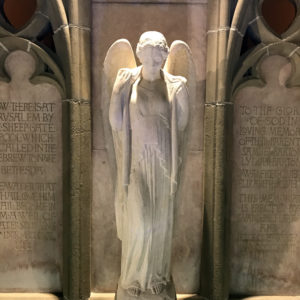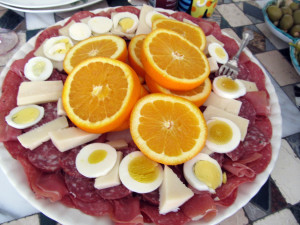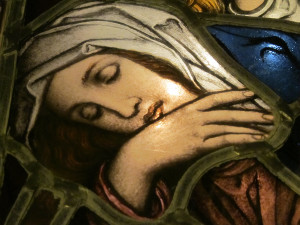I am writing this in a church, which probably is not very reverent of me. It is the overnight watch, as Holy Thursday dissolves into Good Friday. The Easter Triduum. Apologies for my irreverence, and also for years of leading you astray, as I’ve told you for years now that lent, that somber season that leads to Easter, ends with the Easter Vigil Mass on Holy Saturday. Well, that’s not true. It ends, I’ve learnt just tonight, with the Triduum of Maundy Thursday, Good Friday, and Holy Saturday. And so I apologize for years of misinformation.
While I’m pretty good with the secular stuff, I am certainly not your best source for liturgical information. Although I love churches (especially old ones), I have not been a very good churchgoer for a while now. My last time in a church was for Dad’s funeral mass last February, before lent even began, and not since last Easter before that. But I love ceremony and I love tradition, and I love this night. It was my grandma Assunta who taught us the tradition of visiting three churches on Holy Thursday, though three may have been a tradition of her own––visiting seven is more traditional, an Italian tradition coming out of the seven basilicas of Rome and the seven stations of the cross. But we do what we know and three is what I have always known. And there are meditations that we are supposed to reflect upon while we are in those churches. But me, I am a visitor. I like to visit and sit in the company of those I love, and so this is what I do here, too. It may be just me and a few other souls in this dark church tonight, but in my heart all the ones I love are with me, too. My whole family. No one is missing. This is especially important to me this year.
Buona Pasqua
Come noon on Holy Saturday, that is today, lent is over. Or so this was the tradition in my grandparents’ home. The day before was Good Friday and my mother recalls that on Good Friday, the home was in a state of mourning, as if there was a wake going on (and back then wakes took place in the home). “You couldn’t turn on the radio,” she says. “You couldn’t even step on the cracks of the sidewalk.” She doesn’t remember whose rule that was, but it was, nonetheless, a Good Friday rule for my mom as a little girl.
But by noon on Holy Saturday, the mood shifted to one of preparation for the next day’s big feast. In their home, the Easter meal was usually lamb: chunks of it braised on the stove with garlic and onion, then mixed with spring dandelion greens, scrambled egg and parsley and grated parmesan cheese. In their dialect from Lucera the dish was called spetsada (and I’m not sure of the spelling, considering this is not true Italian). The lamb and the eggs bring important symbolism to the Easter table, foods we take in that tell the story of spring’s renewal through subtle hints of sacrifice and resurrection.
At Grandma Cutrone’s table, the meal was typically a fancy pasta dish like ravioli. And this typically is what our Easter table holds, too. The ravioli are always homemade and that part of the meal is always preceded by a special Easter antipasto called la fellata. It begins with a large platter (we like abundance, so the larger the better!). First on the platter are paper thin slices of salami and prosciutto, and atop them, rounds of pepperoni and soppresata, sliced hard boiled eggs, wedges of sharp provolone and slices of fresh mozzarella. In the very center goes an Italian basket cheese, which we usually call “cheese in the basket,” but just as my grandparents all spoke their particular dialects of the Italian language, even “basket cheese” seems like a sort of Italian-American dialect. Its proper Italian name might be canestrato, but basket cheese seems its most prevalent name, and the name comes from the cheese being formed inside a basket––once reed but now most often plastic––so that the impression of the basket is apparent in the finished cheese once it is removed from the basket and placed on the table. Sometimes, if the platter is just too close to overflowing, we might place the fresh mozzarella and the basket cheese in a platter of their own. If your fellata is to be truly delicious, you’ll procure all of these items from a good Italian market, rather than from the supermarket. (When’s the last time you had good fresh mozzarella from the supermarket?)
What separates Grandma Cutrone’s version of la fellata from that of my mother’s family is the addition of sliced oranges. Perhaps they began as leftovers from Grandma Cutrone’s St. Joseph’s Day altar in March, for she always placed baskets of oranges at her altar for St. Joseph. No matter how or why, the sliced oranges brighten the platter. They are cut in thick rounds with one slice from the center out to the peel, so that the orange sections can be pulled apart into a big toothy grin. And of course colored eggs and baskets of the taralli that were the focus of the last chapter of the Book of Days. (I included a recipe for taralli there should you be looking for a good Holy Saturday project.)
Getting through the meal at the Easter table at our house takes hours. Like the Easter Vigil Mass that begins at sundown tonight, it is an occasion not for the faint of heart. It is an event for which one brings a hearty appetite for food and for life. And as we toast each other at that table so we toast you: Buona Pasqua a tutti!
Good Friday, 1613. Riding Westward
It’s Good Friday. This is a favorite poem of mine by John Donne. The language is old, but it takes not very long to become attuned to the spelling and cadence, so allow yourself that for this Second Day of the Easter Triduum.
Let mans Soule be a Spheare, then, in this,
The intelligence that moves, devotion is,
And as the other Spheares, by being growne
Subject to forraigne motion, lose their owne,
And being by others hurried every day,
Scarce in a yeare their naturall forme obey:
Pleasure or businesse, so, our Soules admit
For their first mover, and are whirld by it.
Hence is’t, that I am carryed towards the West
This day, when my Soules forme bends toward the East.
There I should see a Sunne, by rising set,
And by that setting endlesse day beget;
But that Christ on this Crosse, did rise and fall,
Sinne had eternally benighted all.
Yet dare I’almost be glad, I do not see
That spectacle of too much weight for mee.
Who sees Gods face, that is selfe life, must dye;
What a death were it then to see God dye?
It made his owne Lieutenant Nature shrinke,
It made his footstoole crack, and the Sunne winke.
Could I behold those hands which span the Poles,
And tune all spheares at once peirc’d with those holes?
Could I behold that endlesse height which is
Zenith to us, and our Antipodes,
Humbled below us? or that blood which is
The seat of all our Soules, if not of his,
Made durt of dust, or that flesh which was worne
By God, for his apparell, rag’d, and torne?
If on these things I durst not looke, durst I
Upon his miserable mother cast mine eye,
Who was Gods partner here, and furnish’d thus
Halfe of that Sacrifice, which ransom’d us?
Though these things, as I ride, be from mine eye,
They’are present yet unto my memory,
For that looks towards them; and thou look’st towards mee,
O Saviour, as thou hang’st upon the tree;
I turne my backe to thee, but to receive
Corrections, till thy mercies bid thee leave.
O thinke mee worth thine anger, punish mee,
Burne off my rusts, and my deformity,
Restore thine Image, so much, by thy grace,
That thou may’st know mee, and I’ll turne my face.


